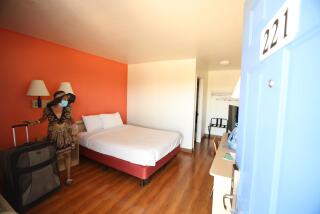Quake Fund Complaints, Disaster Problems Cited
The federal financial aid being offered to victims of the Oct. 1 earthquake is often inadequate to meet their needs, a Whittier official told a specially convened state committee Thursday.
Other local officials told the state Seismic Safety Commission’s Emergency Planning and Response Committee that breakdowns in communications systems were their biggest problem in the hours immediately after the quake.
Sonny Morkus, emergency services director for the hard-hit city of 70,000, said the federal loans being offered at 8% interest are “a big disappointment.”
“People can get at least that interest rate or lower from our local institutions,” Morkus told the committee members gathered for the first of two days of public hearings at Whittier City Hall.
Morkus also said the $100,000 limit on loans to homeowners and $500,000 limit on loans to local businessmen are “not enough” to rebuild many of the structures destroyed or severely damaged by the quake.
“People stand in line for hours to get help, and some of them aren’t getting their needs met,” Morkus said outside the hearing room. “We need state legislation to provide for people not covered by the federal program.”
Gov. George Deukmejian has called for a special session of the Legislature next month to address such concerns.
Los Angeles County Fire Capt. Michael Andrade, Deputy County Fire Chief Bill Zeason, Whittier Police Chief James Bale, Whittier Public Works Director Dave Mochizuki, Whittier Public Services Director Lew Sandoval and Whittier Building and Safety Director Richard Hubinger were among the local officials who testified about difficulties with radio and telephone systems in the first few hours after the quake.
‘Serious Problem’
“Communications became a very serious problem for everybody,” said Zeason, who reported that department dispatchers were “deluged,” trying to handle four times the normal load of incoming calls during the first five hours. Fortunately, he said, a lot of the calls were for information rather than requests for help.
Andrade said that while the department’s “white” emergency radio frequency was so busy that he could not use it, the secondary “blue” frequency, backed up by a ham radio operator dispatched to his fire station in Whittier, enabled him to keep in touch with his personnel.
Mochizuki, Sandoval and Hubinger all suggested the purchase of additional hand-held, two-way radios to use in cases of emergency.
Andrade, who was on duty at 7:42 a.m. when the temblor hit, said he had another problem--it took more than an hour and a half before Whittier’s emergency operations center (EOC) went into operation.
Donald Anthony, a deputy chief with the Los Angeles Fire Department, said that in contrast to Whittier’s, the Los Angeles emergency operations center began operating about 11 minutes after the quake.
Among his recommendations, Andrade proposed that a “time frame be established in which EOCs are to be manned and operational.”
More to Read
Sign up for Essential California
The most important California stories and recommendations in your inbox every morning.
You may occasionally receive promotional content from the Los Angeles Times.










